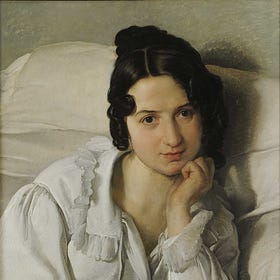I Learned "How To Be Sick"—And It Changed Everything
How illness taught me hope, compassion, and presence
Content note: This essay mentions chronic illness, pain, and moments of despair, but is ultimately about finding hope.
About four years ago, I picked up a book by Toni Bernhard called How To Be Sick, and it fundamentally changed my life. Not only did I see myself in Bernhard’s own history of sudden, mysterious illness, but at the time I was in such a low state mentally and spiritually. I had hit rock bottom. I was desperate to release, to let go, to change my inner world.
So, as a love note to this magical book, I’d like to share some of the practices in it, how I’ve personally adapted them, and what changes I’ve seen in my own life. There are many more practices I won’t cover, and I think part of the power of this book is how it offers something that resonates with every type of mind and soul. You can take the ones that work and leave the rest. In writing this, I also reread much of the book, and I was surprised at how many new practices jumped out at me. Ones that didn’t resonate when I first read it are now sinking in deeper. If you find yourself connecting with the practices here, I couldn’t recommend picking up a copy of this book more wholeheartedly.
Bernhard lays the groundwork by introducing the Four Noble Truths of Buddhism. The first of these truths is about dukkha, a word in Pali, an ancient Indian language. It’s a tough word to translate, but some of the many possible meanings are suffering, unsatisfactoriness, anguish, stress, discomfort, and dis-ease.
The Buddha described life as “the realm of the ten thousand joys and the ten thousand sorrows.” Life is dukkha, but not only dukkha.
Bernhard says, “The first noble truth—the fact of dukkha—helps me accept being sick because that fact tells me my life is as it should be.” I too find this truth comforting. What a relief! I am not broken. Life is fundamentally stressful and uncomfortable, so I am not alone in feeling this way.
The Buddha taught dukkha and, through his Four Noble Truths, the end of dukkha. But he wasn’t referring to ending suffering, discomfort, or pain within the body. These are, unfortunately, inescapable parts of being human. The only way to find peace is to end the suffering in our minds.
Life is going to do what it does. There will be discomfort and pain. But when we resist this reality, we create suffering on top of suffering.
For example, you may be at the post office waiting in a long line one day, thirsty and with your back aching. You’d rather not be there, so you tense up your body and fill your mind with thoughts like, “Ugh, this sucks. I don’t want to be here. These workers are so slow. I just want to go home. My back hurts so badly. Why is this happening to me?”
This is the suffering on top of suffering. If you need to stay in that line to send out a piece of mail, and you don’t have the option of leaving, then the reality is that you must wait. The only thing in your control is your own mind and your own reaction to the situation.
Now imagine responding differently. Instead of tensing up with anger and letting negative thoughts fill your mind, you relax. You give yourself peace. You might say to yourself, “There is pain, but I don’t have to suffer over it. There is thirst, but I don’t have to be consumed by it.” You breathe deeply. Your back pain lessens, because you are not tense. The resistance in your mind lessens, and you feel calm even in the midst of discomfort.
This is not full enlightenment in the Buddhist sense, but it is a glimpse of the practice that leads there. You’re not erasing pain or discomfort or even denying it, but you’re no longer multiplying your suffering through resistance and grasping. This ability to meet reality as it is, with calm presence, is one of the qualities on the path to awakening.
Another practice I love that Bernhard shares is called “The Broken-Glass Practice.” This one is inspired by the Buddhist monk Ajahn Chah. It’s a practice of anicca, or impermanence.
Here’s a passage from Ajahn Chah’s book Food for the Heart:
“You say, ‘Don’t break my glass!’ Can you prevent something that’s breakable from breaking? It will break sooner or later. If you don’t break it, someone else will. Penetrating the truth of these things, [we see] that this glass is already broken. Whenever you use this glass, you should reflect that it’s already broken. Use the glass, look after it, until the day when it slips out of your hand and shatters. No problem. Why not? Because you saw brokenness before it broke!”
Bernhard talks about the comfort of realizing that this change in her life will befall everyone at some point and quite possibly by surprise. This is simply how and when it happened to her. Every aspect of life is uncertain, unpredictable, and in constant flux. We can look after each moment, cherishing what we can still do, aware that everything can change in an instant. And when it does change, we know it was always going to break.
There’s a peace I feel when I think of life this way. It’s like I hold things less tightly, less preciously. Without impermanence, nothing could grow or develop—not a seed into a tree, not a child into an adult. Gratitude wells up when I imagine how everything will change, because I feel so much appreciation for what I have now.
Beyond impermanence, Bernhard also explores practices that cultivate the heart directly, known as the brahma viharas. Vihara, in Pali, means “dwelling place.” My three favorites are Metta (loving-kindness), Karuna (compassion), and Upekkha (equanimity). I use these three practices often as a place for my mind to dwell when tough emotions overcome me.
Metta is an act of well-wishing toward yourself and others. The practice starts by choosing a set of phrases that is personal and meaningful to you. They can be any phrases as long as their theme is well-wishing.
The metta I settled on was:
May I be at peace.
May I be whole.
May I reach the end of suffering
and be free.
Traditionally, metta practice begins with yourself and then expands outward to different groups of people. It’s a heart opening practice. You’ll first say your phrases to yourself. After you feel open to this, you’ll direct your phrases to someone you feel grateful for, someone who it’s easy to feel compassion for. Then you’ll move on to a person you may have conflicting feelings about (perhaps a loved one or a friend). Next, you’ll say your phrases to someone who you don’t have an opinion about (perhaps someone you interact with at a shop in passing). Finally, you’ll direct your phrases to someone you feel strong anger or judgment toward.
At first, it may be quite hard to send metta to someone you feel such negative feelings toward. But if you keep practicing until you truly see that all humans deserve loving-kindness, it can be a powerful experience.
One of the practices I realized I needed most after reading How To Be Sick was Karuna or compassion. Bernhard focuses on cultivating self-compassion, which for many of us is very hard to do. In starting this practice myself, I realized I had very little compassion for myself.
In Commentaries on the Diamond Sutra, Thich Nhat Hanh writes:
“When our left hand is injured, our right hand takes care of it right away. It doesn’t stop to say, ‘I am taking care of you. You are benefiting from my compassion.’”
He illustrates how the body naturally responds with compassion to our own suffering. With practice, we can condition the mind to respond compassionately to our pain in this same way the body naturally does.
I use this practice often. I’ll start by finding words that address the source of my suffering or stress, which often lie in my desire for things to be other than they are.
When I’m lying in bed during a flare-up and cannot move, I’ll often say to myself, “Little one, I know this is so hard. I know you don’t want to be in pain.” I’ll stroke my own arm soothingly and let whatever emotions flow through without judgment. I’ll think of myself as a small child and treat myself how I would treat any child in distress.
The practice of stroking your own arm is something Bernhard shares from Thich Nhat Hanh, in his Commentaries on the Diamond Sutra. She says, “This has brought me to tears many times, but tears of compassion are healing tears.” I agree. This practice often brings me to tears too. And afterward, I feel my inner child has healed a little more.
The next practice, upekkha or equanimity, goes hand in hand with compassion for me. Equanimity is a calmness and composure, an evenness of mind, especially in a difficult situation. It’s a mindstate that helps us face the difficulties of life with peace.
When I first read How To Be Sick, this was the practice I adopted straightaway. It was the one that helped me see most clearly how, yes, there was suffering in life, but there was also suffering I was placing on myself. The suffering on top of suffering. And the only one I had control over was the one within my mind.
Equanimity, in essence, is accepting life as it comes without blaming anything or anyone, especially ourselves. This is where it ties into my own journey of self-compassion. This practice helped me to stop blaming myself for my own illness.
This might be my favorite quote in the entire book. It comes from Ajahn Chah, a Thai Forest monk, in his book A Still Forest Pool:
“If you let go a little, you will have a little peace. If you let go a lot, you will have a lot of peace. If you let go completely, you will know complete peace and freedom. Your struggles with the world will have come to an end.”
I adapted this into a statement I could say to myself in any situation where I feel resistance to what is. The format loosely is: “I don’t want ____ but ____ is what’s happening, so can I give myself a little peace?”
For example, if I’m lying in bed in pain, I’ll say, “I don’t want to be in pain, but I am in pain. So can I give myself a little peace?” Every time I use this phrasing, I feel the tension in my muscles lessen. I feel my resistance to the present moment ease. It reminds me that even letting go a little can bring a little peace.
And sometimes, a little peace is all you need to find hope again.
My gratitude for How To Be Sick is immense. It gave me tools that lifted the darkness in my life, and four years later, they continue to unfold like a practice of hope.
If suffering is inevitable, and everything is already changing, how might you meet yourself with a little more compassion right here, in this moment?
Read some of my other recent pieces here:
How to Crawl Out of a Black Hole: A Practice
Content note: Chronic illness, pain, disability, mental health, medical trauma.
A Conversation with Madelleine Müller on Making Music from Bed, Grief as Practice, and Reclaiming Enoughness
In the fourth edition of Conversations Behind the veil, I spoke with Madelleine Müller—disabled musician, writer, and creator of The Bed Perspective, a Substack that traces the contours of life, art,…
The Books That Found Me in Bed
I grew up an avid and hungry reader. It was one of my favorite pastimes, fueled by my magical autistic focus. I’d spend summers and weekends in bed, reading for entire afternoons.






I wish I could like this post a thousand times! 💖 Reading 'How to be sick' was a revelation for me. It's like she was reading my mind. Every word she wrote felt like a soothing, guiding hand.
Darling Vōx you have expressed so eloquently the same ways this book has also helped me. I also carry with me the pocket companion of the book. Thank you 🥰
this book was transformative for me as a sick person as well, i've read it many times, it opened me up to a new way of thinking and treating myself. i'm glad you're spreading the word!